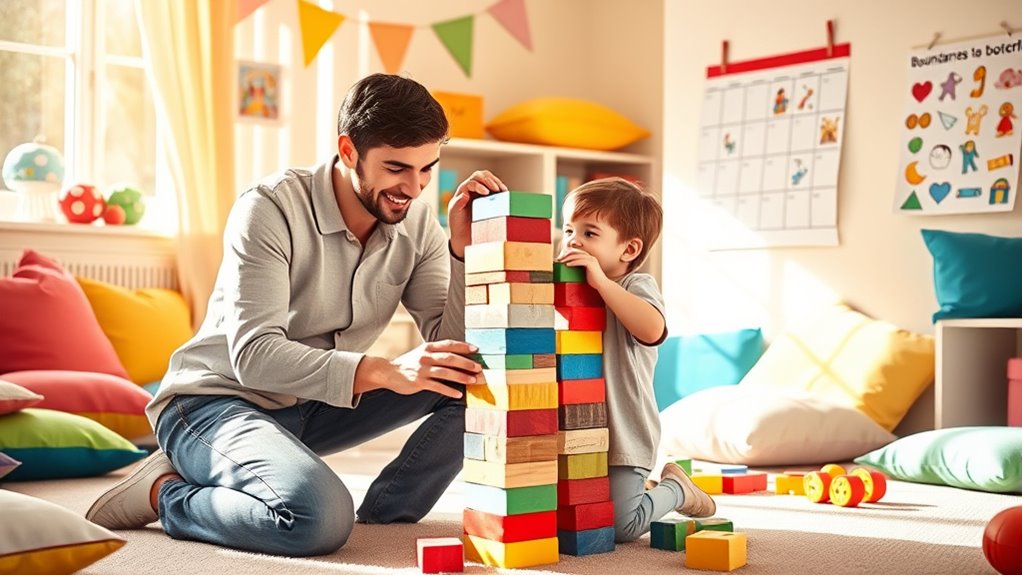To practice positive discipline through playful limits, turn boundaries into fun and engaging experiences. Use games, stories, or pretend play to make setting rules enjoyable, which helps your child understand and follow them more willingly. Involve your child in the process and celebrate successes to boost motivation and cooperation. This approach fosters a sense of safety and respect while making discipline less stressful. Keep exploring for more tips to create a nurturing, playful environment that encourages growth.
Key Takeaways
- Use games and storytelling to make boundary enforcement fun and engaging for children.
- Involve children in setting rules to foster ownership and positive attitudes toward limits.
- Reinforce boundaries with praise and small rewards to motivate compliance and build understanding.
- Tailor boundaries to age and development, ensuring they are clear, realistic, and achievable.
- Create a nurturing environment by combining playful techniques with positive reinforcement and respect.

Creating boundaries with a playful approach can make discipline more effective and less stressful for both you and your child. When you incorporate motivational strategies into setting age-appropriate boundaries, you turn discipline into a positive experience rather than a source of conflict. Instead of relying solely on commands or punishments, you motivate your child to understand the importance of limits through engaging and encouraging methods. For instance, using praise when they follow rules or offering small rewards for consistent good behavior can inspire them to stay within boundaries willingly. This approach helps your child feel valued and understood, making them more receptive to the boundaries you set.
Playful boundaries and positive reinforcement make discipline engaging and effective for children.
It’s essential to tailor your boundaries to your child’s age and developmental stage. Age-appropriate boundaries are realistic, clear, and achievable, helping your child learn self-control without feeling overwhelmed. For young children, simple limits like “no hitting” or “stay in your bed” are straightforward and easy to understand. As they grow, you can gradually introduce more complex boundaries, such as managing screen time or completing chores, always keeping the expectations within their capacity. When boundaries are appropriate for their age, children are more likely to see them as manageable challenges rather than insurmountable obstacles. This clarity reduces frustration and promotes cooperation.
Using playful methods to enforce boundaries transforms discipline into a fun and engaging process. Instead of shouting or issuing stern commands, you can turn setting limits into a game or a story. For example, if your child needs to put away toys, you might create a race to see who can clean up the quickest or pretend the toys are treasures that need to be stored safely. This playful approach captures their attention, making the act of following boundaries feel less like a chore and more like an adventure. When children associate boundaries with positive experiences, they’re more likely to internalize rules naturally and with enthusiasm.
Motivational strategies also include involving your child in the boundary-setting process. Ask them what they think is fair or how they’d like to see limits implemented. This inclusion fosters a sense of ownership and responsibility, encouraging compliance out of respect rather than fear. Additionally, celebrating successes with enthusiastic praise or small rewards reinforces positive behavior and motivates your child to continue respecting boundaries. Remember, the goal isn’t just compliance but helping your child understand why limits matter and how they contribute to their safety and growth. Incorporating positive reinforcement techniques makes the process more engaging and effective. By combining age-appropriate boundaries with playful, motivational strategies, you create a nurturing environment where discipline becomes an empowering experience for both of you.
Frequently Asked Questions
How Does Playful Discipline Impact Long-Term Behavior?
Playful discipline positively impacts long-term behavior by helping you build strong, respectful relationships with your child. When you use playful limits, you teach essential parenting strategies that promote cooperation and emotional regulation. This approach encourages your child to develop self-discipline and problem-solving skills, making good behavior more natural over time. By staying consistent and playful, you foster a trusting environment that influences their behavior well into the future.
What Age Is Best Suited for Playful Limits?
Think of a sturdy oak tree standing tall in a garden; playful limits work best for kids aged 2 to 7, when they’re developing their independence. During this stage, their developmental readiness makes age-appropriate boundaries effective, helping them learn self-control with gentle guidance. You’ll find that using playful limits during these years fosters cooperation and emotional growth, setting a strong foundation for positive behavior as they grow older.
Can Playful Limits Be Adapted for Children With Special Needs?
Yes, you can adapt playful limits for children with special needs by incorporating flexible, personalized strategies. Focus on sensory considerations, like using calming textures or sounds, to create a supportive environment. Adjust your approach based on your child’s unique needs, ensuring the limits are playful and encouraging. By being attentive and responsive, you help your child learn boundaries while respecting their sensory and developmental differences.
How Do I Handle Resistance to Playful Discipline?
You might find it surprising, but resistance often signals that your child needs more behavioral consistency and emotional resilience. When faced with resistance, stay calm and steady, demonstrating the limits with patience and playfulness. Keep your approach consistent, so your child understands what to expect. By modeling resilience and maintaining a positive, playful attitude, you help your child feel secure, eventually reducing resistance and fostering cooperation.
Are There Cultural Differences in Implementing Playful Limits?
Yes, there are cultural differences in implementing playful limits because cultural norms influence disciplinary practices. You might find that some cultures prefer more authoritative approaches, while others embrace playful, collaborative methods. When applying playful limits, consider respecting these norms and adapting your approach accordingly. By understanding and honoring cultural differences, you create a more effective and respectful environment that promotes positive discipline tailored to your child’s background.
Conclusion
By setting playful limits, you teach responsibility, foster respect, and build trust. You create boundaries that guide behavior, encourage independence, and nurture understanding. You establish rules that promote safety, support growth, and develop self-control. Through positive discipline, you empower your child to learn, adapt, and thrive. With patience and consistency, you turn challenges into opportunities, discipline into growth, and limits into love. Embrace playful limits, and watch your child’s confidence and connection flourish.










